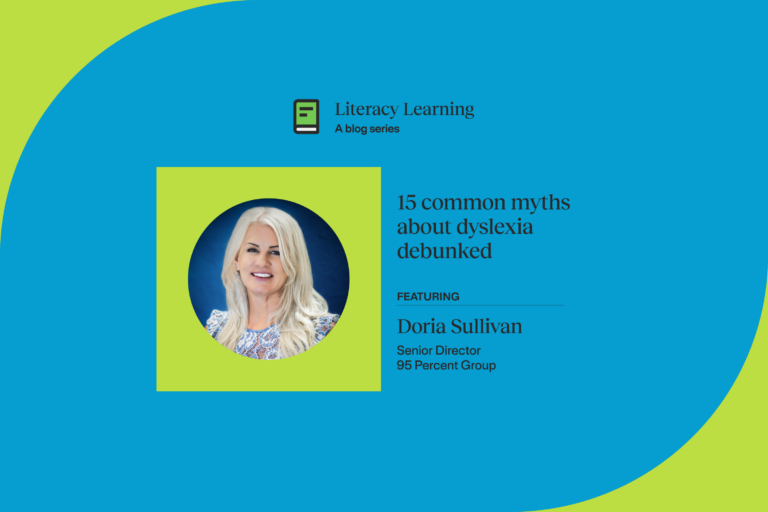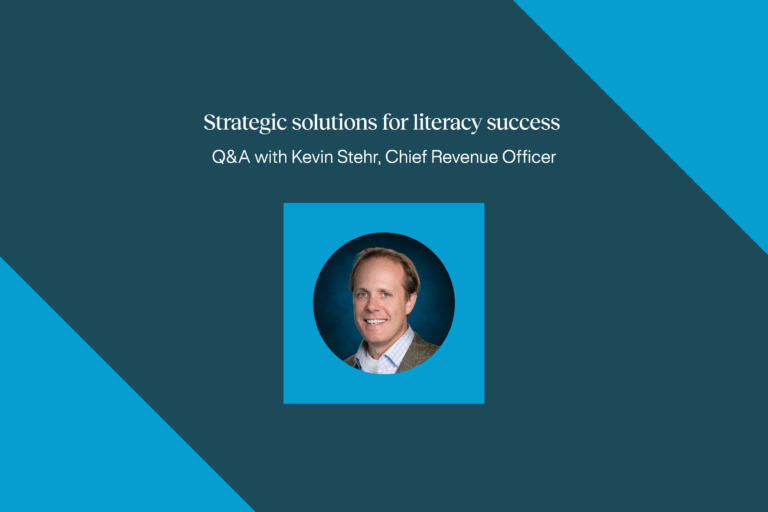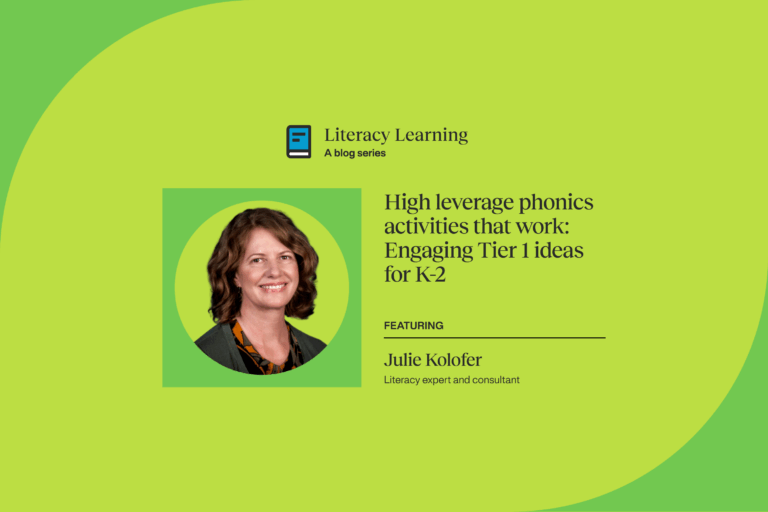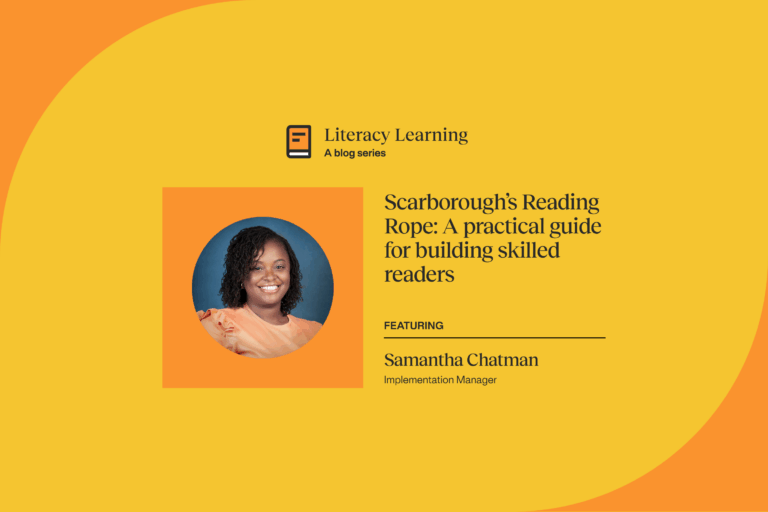15 common myths about dyslexia debunked
A post from our Literacy Learning: Science of reading blog series written by teachers, for teachers, this series provides educators with the knowledge and best practices needed to sharpen their skills and bring effective science of reading-informed strategies to the classroom.

Dyslexia is a neurological learning disability where the brain struggles to process and understand words and letters. Unfortunately, dyslexia is often misunderstood, leading to misconceptions that can lead to delays in its diagnosis and effective educational instruction.
“The lack of understanding of dyslexia is rooted in a lack of understanding in how we learn to read,” explains Doria Sullivan, the senior director of implementation management with 95 Percent Group and mother of a child with dyslexia.
At 95 Percent Group, our educators know how important it is to foster a supportive and inclusive learning environment for all students, especially those with learning differences like dyslexia. In this article, we’ll explore some of the most common myths about dyslexia and provide the facts you need to better understand this learning disability. We’ll break down each myth with research-backed facts that clarify the truth behind the confusion. Plus, we’ll offer a top takeaway to help guide educators’ approach in the classroom and ensure teachers are equipped to support all students.
Myth #1: Writing letters backward or upside down is always a sign of dyslexia
One of the most pervasive dyslexia myths is that writing letters backward or upside down is a sure sign of dyslexia. The truth is, it is quite common for many beginning readers and writers to confuse and reverse letters. It is a normal part of learning to write for many young children as they develop fine motor skills and learn letter formation. Students with dyslexia may have problems sequencing letters based on sound, so they may try to write or read based on memory. Additionally, students with dyslexia may have trouble remembering and quickly accessing words, letter names, and sounds but not necessarily copying them. As such, it’s important to monitor letter reversals in the context of other behaviors and symptoms.
The top takeaway: Look beyond letter reversals. If you notice persistent reversals or transposed letters beyond the end of first grade, along with struggles decoding and spelling, those might be signs of dyslexia and warrant additional assessment.
Myth #2: Dyslexia is a visual problem and students with dyslexia see letters and words backwards
“People think that dyslexia is a visual or eyesight problem,” shares Doria Sullivan. “It has nothing to do with that.”
Dyslexia is often misunderstood as a visual issue, but in reality, it’s a language-based learning difference. It’s important to emphasize: dyslexia is not caused by problems with vision. There is no scientific evidence linking visual issues to dyslexia. Instead, students with dyslexia face challenges with phonological processing, which means they struggle with connecting sounds to letters and decoding words. This difficulty with recognizing and manipulating sounds in words is the core of dyslexia and not a visual impairment.
The top takeaway: Dyslexia affects how the brain processes language, not how we see it. Understanding this distinction helps to ensure proper interventions and support for students with dyslexia.
Myth #3: The use of covered overlays and/or dyslexia fonts is a good treatment for students with dyslexia
Because dyslexia is often mistakenly thought to be a visual issue, many well-meaning individuals advocate for solutions that fail to address the core challenges these students face. The myth that colored overlays and dyslexia fonts are effective treatments for dyslexia overlooks the fact that these tools do not address the core difficulties of dyslexia, which are related to phonological processing. Proponents of colored overlays and/or dyslexia fonts often cite benefits for students who report visual stress or discomfort when reading. However, studies have shown no consistent evidence that overlays improve reading accuracy, fluency, or comprehension for students with dyslexia.
The top takeaway: Dyslexia is about how the brain processes language, not vision, so the best support is structured literacy instruction focused on phonemic awareness and decoding.
Myth #4: Students with dyslexia have a low IQ and are generally not as bright as their peers
Research has debunked the prevalent myth that students with dyslexia have a low IQ or are less intelligent than their peers. Remember, dyslexia is a specific learning difference related to language processing, not a reflection of intelligence. In fact, many students with dyslexia are highly intelligent and capable learners. Dyslexia simply affects how they process written and spoken language, not their overall cognitive abilities.
The top takeaway: Dyslexia does not correlate with a low IQ and can impact anyone—regardless of intelligence, and every person with dyslexia is different—with their own set of strengths and challenges.

Myth #5: People with dyslexia are gifted in other ways
While people with dyslexia may excel in other areas, such as problem-solving, creativity, and critical thinking, research shows dyslexia and giftedness are not inherently linked. Giftedness is defined in the traditional sense as those with advanced cognitive abilities that are beyond what is typically expected among their age group. Giftedness is not diminished by the presence of dyslexia or vice versa.
The top takeaway: While people with dyslexia may have strong compensatory strategies, studies have not shown a direct correlation between dyslexia and giftedness.
Myth #6: There is only one definition and description of dyslexia
Dyslexia is complex and multifaceted, and it’s important to understand that no single definition fully encompasses the diversity of experiences of dyslexia.
The most widely referenced definition is from the International Dyslexia Association (IDA) from 2002. The IDA defines dyslexia in part as “a specific learning disability that is neurobiological in origin. It is characterized by difficulties with accurate and/or fluent word recognition and by poor spelling and decoding abilities.” The definition goes on to guide educators and families in using evidence-based interventions to meet the unique needs of these learners. Having a common definition and understanding of dyslexia, like the one provided by the IDA, ensures consistency in identifying and supporting individuals with dyslexia. However, keep in mind that there are slight variations in definitions since dyslexia manifests differently across individuals.
The top takeaway: While the IDA dyslexia definition is commonly referred to and trusted for promoting early identification and effective literacy support strategies, there’s no one definition for dyslexia.
Myth #7: There is a single assessment to determine if a student has dyslexia
There is no single test for diagnosing dyslexia. According to experts like dyslexia researcher and professor Dr. Timothy Odegard, a comprehensive evaluation is necessary to diagnose dyslexia accurately. This comprehensive approach might include assessing:
- multiple aspects of reading
- phonological processing
- language skills
Professionals like educational psychologists, speech-language pathologists, or reading specialists conduct these evaluations, often using standardized tools. This approach ensures a well-rounded understanding of the individual’s reading challenges and underlying deficits.
The top takeaway: Dyslexia cannot be identified through one test alone. Dyslexia is a multifaceted and nuanced condition that requires multiple assessments to evaluate its various components effectively.
Myth #8: Only 5% of the population has dyslexia
Determining the exact number of individuals with dyslexia is difficult due to varying definitions and the overlap of symptoms with other reading issues. However, dyslexia is more common than many people think. The IDA notes that up to 15-20% of the population has dyslexia, depending on the criteria used.
“Think about a classroom,” explains Doria Sullivan. “I’m not talking about just one student. In a class of 40, there are likely several children who are at risk for a reading impairment/dyslexia.”
Many students with dyslexia go undiagnosed, especially if their struggles are mild or masked by strong coping strategies. Dyslexia, like other learning disabilities, exists on a spectrum, and affects individuals differently with varying impacts.
The top takeaway: We will never have an exact count of individuals with dyslexia until there is a universal definition and a more accurate method to distinguish dyslexia-specific symptoms from other types of reading difficulties. Dyslexia affects a significant number of students, so it’s important to understand how to recognize and support them in the classroom.
Myth #9: Dyslexia predominantly affects more boys than girls
Research shows that boys are more likely to be diagnosed with dyslexia than girls, but the difference is not as large as commonly believed. Studies indicate that dyslexia affects both genders, although some research suggests that referral bias in school identification processes tends to favor boys during the identification process. This is often because of other issues that call attention to them, such as ADHD or behavior issues.
The top takeaway: Dyslexia affects both boys and girls, and early identification is crucial for all students, regardless of gender, to ensure they receive the support they need.
Myth #10: If a parent has dyslexia, their child is guaranteed to have dyslexia
While dyslexia has a genetic basis and often runs in families, it is not guaranteed that a child will inherit the condition. Research by Pugh and Fletcher highlights that dyslexia is influenced by both genetic predispositions and environmental factors. Children of a parent with dyslexia have a higher risk (estimated at 40-60%) but early exposure to literacy-rich environments and evidence-based interventions can mitigate the impact of genetic risk.
The top takeaway: Although a family history of dyslexia increases the likelihood of reading challenges, proactive measures like early screening and targeted intervention can help children overcome potential difficulties. Genetics is a factor, but it doesn’t solely determine outcomes.
Myth #11: Dyslexia cannot be identified before 2nd or 3rd grade
Dyslexia can be identified well before 2nd or 3rd grade. According to the IDA, early signs of dyslexia often appear in preschool and kindergarten. We can screen for at-risk factors as early as preschool. Formal universal screening starting in kindergarten is an ideal way to identify students at risk for dyslexia before they start falling behind in reading.
Early signs of dyslexia may include difficulties with rhyming, recognizing letters, or connecting sounds to letters. According to research, students demonstrating difficulty performing phonemic awareness tasks have a higher probability of struggling with word reading and spelling. Another reliable predictor of dyslexia is the failure to make gains in reading when a student has been provided with high-quality literacy instruction.
The top takeaway: Dyslexia can be identified early, sometimes even before formal reading instruction begins. It’s always critical for schools to use screening and diagnostic assessments to identify students who are not meeting early benchmarks of skilled reading.

Myth #12: It’s too late to help a student with dyslexia when they exit elementary school
It’s never too late to help a student with dyslexia! While early intervention is ideal, students can make significant progress at any age with the right instruction. All students, especially older ones, benefit from structured literacy approaches that focus on decoding, spelling, and building vocabulary, along with strategies for comprehension and writing.
According to Doria Sullivan, sometimes general education teachers will see dyslexia as something only for special education instructors to take the lead on within classrooms. But when general education teachers know how dyslexia works, they can make a huge difference with their students.
“Having a basic understanding of dyslexia will impact not just how they teach their students with dyslexia,” explains Doria Sullivan. “It leads them to structured literacy, which we know is a way to make sure that all students learn how to read.”
The top takeaway: Every student, no matter their age, can grow as a reader and writer with targeted appropriate literacy support. It’s never too late to make a difference.
Myth #13: Students can outgrow dyslexia
Dyslexia is a lifelong condition rooted in how the brain processes language and is not something students “outgrow” according to the IDA. But here’s the good news: with the right evidence-based reading instruction and support, students with dyslexia can learn to accurately read, spell, and succeed.
The top takeaway: Dyslexia doesn’t go away, but with the right strategies and support, students can overcome it. The provision of appropriate high-quality effective instruction and early intervention really make all the difference!
Myth #14: People with dyslexia should learn compensatory strategies
Another myth is that people with dyslexia should learn compensatory strategies to read. While those who are dyslexic may excel at certain compensatory strategies, with systematic, explicit, evidence-aligned instruction, people with dyslexia can really learn to read just like every other student in the classroom.
“We need to prioritize teaching reading through a structured literacy approach rather than a balanced literacy approach, which often relies on the use of leveled text and sometimes assumes that simply putting books in students’ hands will lead them to read on their own,” shares Doria Sullivan.
Top Takeaway: People who are dyslexic can learn to read well using the same tactics as other readers: systematic, explicit, evidence-aligned instruction.
Myth #15: If you have dyslexia you will never learn to read well
Just because people have dyslexia doesn’t mean they will never learn to read well. While dyslexia is a lifelong condition, people who have dyslexia can learn to read well. That educational journey begins by having instructors who understand what dyslexia is and how best to work with students who have it.
“The first landing space I typically have everyone go to is to IDA’s website,” explains Doria Sullivan. “They have fact sheets that get into the nuts and bolts to gain a basic understanding of dyslexia. I think that’s a good starting point for instructors, and it’s one of those things that everybody should know about.”
Top Takeaway: Dyslexia isn’t an insurmountable barrier to education. In fact, those who are diagnosed with dyslexia can become good readers who are skilled and confident.
Understanding the basics of dyslexia
Understanding and supporting students with dyslexia is essential for creating an inclusive and effective classroom. Dyslexia is often misunderstood, leading to myths that can hinder education, instruction, and support. By debunking common myths and embracing evidence-based practices, educators can better identify and meet the needs of their students.
“We always talk about what is that students with dyslexia need? It’s really what all students need which again is more of a structured literacy approach,” says Doria Sullivan.
For those looking to dive deeper into practical strategies, taking 95 Percent Group’s “Top Ten Tools” course is an excellent way to gain valuable insights into effective literacy instruction, especially for struggling readers including those with dyslexia. With proven tools and techniques, this course provides educators with the knowledge they need to enhance their teaching practices and help all students succeed in reading. When educators are informed and proactive, they not only help students with dyslexia succeed academically but also contribute to their personal growth and lifelong learning journey.

Expert Biography
Doria Sullivan, Senior Director of Implementation Management, 95 Percent Group
A fierce science of reading advocate, Doria grew up in New York and moved to Las Vegas, Nevada where she attended UNLV for both her undergraduate and graduate degrees (B.S. in Elementary Education and M.Ed. in Curriculum and Instruction). Shortly after graduating, she moved to North Carolina for 20 years where she was an Elementary and Special Education Educator, District Literacy Program Manager, Adjunct Professor, and State Department Literacy Consultant. She left public education to become a national trainer and Executive Director of Language Essentials for Teachers of Reading and Spelling (LETRS), advancing professional learning in the science of reading across the United States.
With a strong background in the science of reading and evidence-based literacy programs and practices, Doria brings a variety of valuable experience to our team as the Senior Director of Implementation and implementation science specialist.
Doria enjoys cooking, spending time with family and friends, and traveling. She enjoys being part of the 95 Percent Group family as her passion aligns to the company’s mission to empower and equip educators with a comprehensive literacy solution which will ensure every child’s success as a literacy learner.
Sources
- Eide, Brock L., and Fernette F. Eide. The Dyslexia Advantage: Unlocking the Hidden Potential of the Dyslexic Brain. Plume, 2011.
- Fletcher, J.M., Lyon, G.R., Fuchs, L.S., & Barnes, M.A. (2019), Learning disabilities: From identification to intervention. NY: Guilford Press.
- Fletcher, J. M., et al. (2019). The neurobiology of dyslexia. Journal of Learning Disabilities, 52(5), 426–442. https://doi.org/10.1177/0022219419873209
- Hasbrouck, J. (2020). Conquering dyslexia: A guide to early detection and intervention for teachers and families. Brookes Publishing.
- Kuster, S.M., van Weerdenburg, M., Gompel, M. et al. Dyslexie font does not benefit reading in children with or without dyslexia. Ann. of Dyslexia 68, 25–42 (2018). https://doi.org/10.1007/s11881-017-0154-6
- Nicolson, R. I., and A. J. Fawcett. “Dyslexia: The Role of the Cerebellum.” Developmental Neuropsychology, vol. 33, no. 3, 2008, pp. 423-438. https://doi.org/10.1080/87565640801996094.
- Odegard, T.N. (2019). Dyslexia defined: Historical trends and the current reality. Perspectives on Language and Literacy, 45. (pg.12)
- Ramus, Franck. “The Relationship Between Language and Reading Disabilities.” Current Directions in Psychological Science, vol. 13, no. 4, 2004, pp. 164-168. https://doi.org/10.1111/j.0963-7214.2004.00294.
- Sayeski, K. L. (2024). Unraveling dyslexia: A guide for teachers and families. Rowman & Littlefield.
- Shaywitz, S. (2003). Overcoming dyslexia: A new and complete science-based program for reading problems at any level. New York: Knopf.
- Sohn, E. (2024, September 1). Untangling dyslexia myths and misconceptions: Persistent misunderstandings about reading struggles have impeded progress in diagnosis and treatment. Monitor on Psychology, 55(6), 40. https://www.apa.org/monitor/2024/09/dyslexia-myths
- Snowling, Margaret J., and Charles Hulme. “Dyslexia and Developmental Disorders: The Role of Cognitive Abilities.” Current Directions in Psychological Science, vol. 21, no. 1, 2012, pp. 35-40. https://doi.org/10.1177/0963721411432473.
- Tanaka, Hiroko et al. “The brain basis of the phonological deficit in dyslexia is independent of IQ.” Psychological science vol. 22,11 (2011): 1442-51. doi:10.1177/0956797611419521
- The International Dyslexia Association. Dyslexia Basics. DyslexiaIDA.org, The International Dyslexia Association, https://dyslexiaida.org/. Accessed 8 Dec. 2024.
- Wagner, Richard K et al. “The Prevalence of Dyslexia: A New Approach to Its Estimation.” Journal of learning disabilities vol. 53,5 (2020): 354-365. doi:10.1177/0022219420920377



